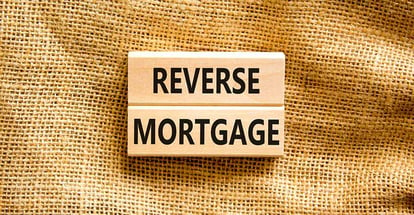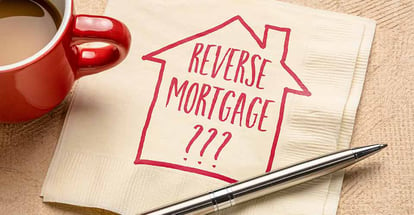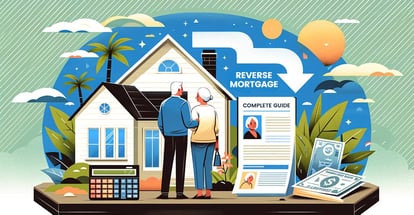Compare a Reverse Mortgage to a Refinance in 2024
Owning a home can be a great investment, especially if you have built up equity over time. Equity is the difference between the market value of your home and the amount you still owe on your mortgage. When you have equity, you can tap into it to get cash for home improvements, debt consolidation, or other expenses.
But with so many options available, it can be tough to decide which route to take. In this article, we’ll explore two popular choices - refinancing your home or taking out a reverse mortgage.
We’ll examine the pros and cons of each to help you make an informed decision about what’s best for your financial situation.
Table of Contents
Is a Reverse Mortgage the Same as a Refinance?
No, a reverse mortgage is not the same as a refinance. A reverse mortgage is a type of loan that allows homeowners to borrow against the equity in their home, typically without having to make monthly payments.
Instead, the loan is repaid when the borrower moves out of the home, sells the property, or passes away.
In contrast, refinancing is the process of replacing an existing mortgage with a new one, often with the goal of obtaining a lower interest rate, shorter loan term, or cash-out option.
Refinancing requires monthly payments and does not involve borrowing against the equity in the home.
While both options may involve changes to a homeowner's mortgage, they are distinct and should be carefully considered based on individual financial goals and circumstances.
How a Reverse Mortgage Works
A reverse mortgage differs from a traditional mortgage in that it utilizes the equity you’ve built up over years of mortgage payments to provide you with payments. These payments can come in the form of a lump sum, monthly payments, or a line of credit.
Reverse mortgages are exclusively available to seniors aged 62 and over who have substantial equity available, typically around 50%.
There are three types of reverse mortgages - home equity conversion mortgages (HECMs), which are backed by the Federal Housing Administration (FHA); proprietary reverse mortgages, provided by private lenders; and single-purpose reverse mortgages, which are generally offered by state and local governments and nonprofits.
What Is a Refinance?
Refinancing involves taking out a new loan to pay off an existing one. This option allows homeowners to access lower rates or payments by obtaining a new loan to cover their current one. Refinancing can lead to substantial savings over time, particularly when interest rates are low.
In addition to accessing lower rates, people may choose to refinance to alter the terms of their loan, such as transitioning to a fixed-rate or adjustable-rate loan or changing the duration of the loan. These changes can potentially reduce monthly payments, depending on the homeowner’s specific financial circumstances.
However, if the goal is to use the savings from refinancing for home renovations that are necessary to age in place, refinancing alone may not be sufficient. In such cases, a reverse mortgage may be a more suitable option.

Pros of Reverse Mortgages
For seniors seeking to bolster their monthly budget, a reverse mortgage can be an attractive option. Unlike a refinance, which may only slightly lower monthly payments, a reverse mortgage has the potential to significantly increase cash flow. This is because a reverse mortgage utilizes the equity built up in a home to provide payments to the borrower.
Moreover, reverse mortgages offer flexibility in terms of how payments are received. Homeowners can choose to receive payments in a lump sum, which can be beneficial for funding home repairs or consolidating other debts.
In contrast, a traditional refinance will only lower the amount paid monthly or change the loan term. If a borrower seeks to receive cash to use as they please, a cash-out refinance would be necessary.
-
A reverse mortgage can provide additional cash flow to supplement a senior's retirement income.
-
It can help seniors age in place by providing funds for necessary home improvements and modifications.
-
Seniors can access the equity in their homes without having to sell or move out.
-
The borrower retains ownership and occupancy of the home during the life of the loan.
-
The loan is non-recourse, which means that the borrower or their heirs will not be held responsible for any loan balance that exceeds the value of the home.
-
There are no monthly mortgage payments required, although the borrower is still responsible for property taxes, homeowner's insurance, and maintenance costs.
-
The loan can be received as a lump sum, a line of credit, or monthly payments, giving the borrower flexibility in how they use the funds.
-
Reverse mortgages are insured by the Federal Housing Administration (FHA), which protects borrowers from lender default.
- The funds received from a reverse mortgage are not taxable and do not affect Social Security or Medicare benefits.
Cons of Reverse Mortgages
While reverse mortgages can provide financial relief, there are potential drawbacks to consider before pursuing this option.
One significant concern is that with each monthly payment, the borrower's equity in the home is depleted. If leaving the home as an inheritance to children is a priority, then a reverse mortgage may not be the best choice.
Another factor to consider is the cost of a reverse mortgage, which tends to be higher than other financial tools.
Since reverse mortgages are non-recourse loans, the Federal Housing Administration (FHA) requires borrowers to pay up-front mortgage insurance premiums of 2% of the total borrowed and an additional 0.5% mortgage insurance premium annually.
The amount of the annual premium is based on the amount borrowed. In contrast, if there is sufficient equity for a home being refinanced, mortgage insurance is not necessary.
-
Depleting equity - With a reverse mortgage, you are essentially borrowing against the equity you have built up in your home, which means you will be depleting it with every payment you receive.
-
Higher costs - Reverse mortgages tend to be more expensive than traditional mortgages. This is because they are non-recourse loans, which means the lender is taking on more risk.
-
Mortgage insurance premiums - As a requirement of the Federal Housing Administration (FHA), reverse mortgages require an up-front mortgage insurance premium of 2% of the total borrowed and an additional 0.5% mortgage insurance premium each year.
-
Potential impact on inheritance - If you plan on leaving your home to your heirs as an inheritance, a reverse mortgage may reduce the value of the gift.
-
Limited eligibility - Reverse mortgages are only available to seniors over the age of 62 who have significant equity available—generally around 50%.
- Counseling requirements - Before obtaining a reverse mortgage, borrowers are required to attend counseling sessions, which can be an added time and financial cost.
Pros of Refinancing
Refinancing is a cost-effective choice for many individuals in the long run. Unlike a reverse mortgage, it does not necessitate a counseling session, which usually costs around $125 per session.
Refinancing typically offers lower interest rates, which means savings on mortgage insurance premiums as well.
Another advantage of refinancing is that it enables you to continue building equity in your home rather than depleting it. By building equity, you can earn more profit when you sell the property or pass it down to your heirs.
Furthermore, refinancing offers additional protection to your spouse compared to a reverse mortgage. If you apply for a reverse mortgage alone, your non-borrowing spouse may be forced to leave the residence if you move to long-term care.
While laws are gradually changing to address this issue, it is still something to consider. Refinancing ensures that both spouses are protected in the event of unforeseen circumstances.
-
Cost-effective in the long run.
-
Does not require a counseling session, saving on counseling fees.
-
Offers lower interest rates, resulting in savings on mortgage insurance premiums.
-
Allows you to continue building equity in your home, resulting in increased profit when you sell or pass down the property.
- Provides protection for both spouses in case of unforeseen circumstances, unlike a reverse mortgage which may leave the non-borrowing spouse vulnerable to displacement.
Cons of Refinancing
If your aim is to completely eliminate your monthly payments, refinancing may not be the best option for you. While you may save money over time, you will still need to make monthly payments to the bank, albeit potentially smaller ones.
However, if you require cash to fund home improvements or to pay for property taxes, which are two common reasons for considering a reverse mortgage, a cash-out refinance may be a more suitable option.
By taking advantage of a lower interest rate or a shorter loan term, you can access a lump sum of cash to cover project costs.
-
Refinancing requires monthly payments, so if your goal is to eliminate monthly payments altogether, it may not be the best option for you.
-
Refinancing usually involves closing costs and fees, which can add up and make the overall cost of the loan higher.
-
If you have already paid a significant amount of interest on your current mortgage, refinancing to a new loan may reset the clock on your payments and result in paying more interest over the life of the loan.
-
If you have a low credit score or a high debt-to-income ratio, you may not be able to qualify for a favorable interest rate, which means that refinancing may not save you as much money as you hoped.
- Refinancing may not be a good option if you plan to sell your home in the near future, as the costs associated with refinancing may outweigh the potential savings.
Can I get a reverse mortgage to pay for home improvements?
Home improvements can be expensive, and many seniors may not have the financial resources to pay for them out of pocket. This is where a reverse mortgage can be a helpful option.
By tapping into the equity that has been built up in their home, seniors can access the funds needed to make necessary renovations and upgrades.
It's worth noting that the amount that can be borrowed through a reverse mortgage is limited by the appraised value of the home, the age of the borrower, and the amount of equity they have in the property.
The older the borrower and the more equity they have, the more money they can potentially receive through a reverse mortgage.
One advantage of using a reverse mortgage for home improvements is that the funds can be received in a variety of ways.
A lump sum payment can be used to pay for larger projects, while a line of credit can be drawn upon as needed for ongoing renovations. Monthly payments can also be arranged to cover regular home improvement expenses.
Do you get cash on a reverse mortgage?
Yes, with a reverse mortgage, you can receive cash in various ways.
The amount of money you can borrow, which is called the "principal limit," is determined by your age, the value of your home, and the interest rate on your loan. Once you have qualified for a reverse mortgage, you have three options for receiving your money.
One option is a line of credit, which means you can borrow money as you need it up to your borrowing limit. Another option is a monthly payout, where you receive a fixed monthly amount for as long as you live in your home.
Lastly, you can receive a lump sum payout, which means you get a one-time payment of the full amount you are eligible to borrow. It's important to note that the amount of cash you receive will depend on several factors and may affect your future equity in the home.
Bottom Line
When considering a reverse mortgage versus a refinance, it's important to weigh the pros and cons of each option carefully.
A reverse mortgage can provide seniors with a source of cash without the need for monthly payments, but it can also reduce the equity in their home and have high fees.
Refinancing, on the other hand, can be a more cost-effective option in the long run, but it still requires monthly payments to the bank.
Ultimately, the decision between a reverse mortgage and a refinance will depend on your specific financial situation and goals. It's always a good idea to consult with a financial advisor or mortgage professional to help you make the best decision for your needs.
If you're considering a reverse mortgage or a refinance and want professional guidance, don't hesitate to reach out to MakeFloridaYourHome.
Our team of experienced mortgage professionals can help you understand the pros and cons of each option and guide you through the process of selecting the best one for your unique situation.
Contact us today to schedule a consultation and get started on your path to financial security.
With over 50 years of mortgage industry experience, we are here to help you achieve the American dream of owning a home. We strive to provide the best education before, during, and after you buy a home. Our advice is based on experience with Phil Ganz and Team closing over One billion dollars and helping countless families.

About Author - Phil Ganz
Phil Ganz has over 20+ years of experience in the residential financing space. With over a billion dollars of funded loans, Phil helps homebuyers configure the perfect mortgage plan. Whether it's your first home, a complex multiple-property purchase, or anything in between, Phil has the experience to help you achieve your goals.


 By
By  Edited by
Edited by 






